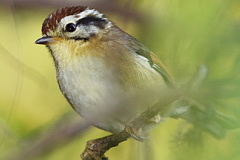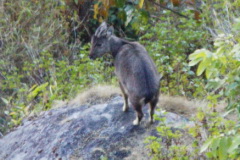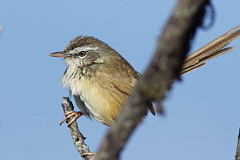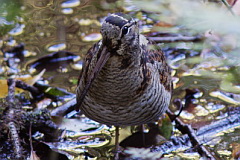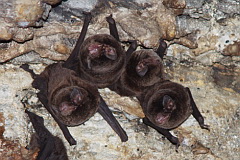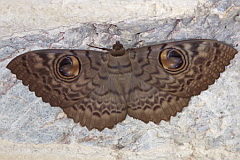Overview
Dates: |
9 - 11 January 2013. |
9 Jan. With Paul Carter, from Phuket, who had been working his way north, visiting various national parks en route. A general birding and mammaling trip with some exploration of new areas thrown in for good measure. |
Arrived Doi Inthanon late morning to be pleasantly surprised to find that the park fees had not as yet been increased as previously threatened. Met up with Paul, and headed down to the Mae Pan area beyond the second checkpoint, where upon arrival had the unpleasant surprise of a boy scout jamboree in full swing with a packed campsite.
Fortunately this was restricted mainly to the camp, so we drove to the end of the road and walked the trail to the Mae Pan Falls, which thankfully had few people. Best birds were a group of 30 Striated Yuhina, Great Iora, Sulphur-breasted Warbler and Claudia's Leaf Warbler. In the mammal line only the usual Pallas's Squirrel. We then took a side track, to find the newly marked Pha Sam Lan Falls, that held a pair of Plumbeous Water Redstart. Forgoing any birding near the campsite we headed back to the Km 34.5 track, which we walked till sunset. Some distant cliffs looked potentially suitable for Goral but were just that - too distant. Birds of interest included Martens's Warbler, Mountain Bamboo Partridge, Hume's Leaf Warbler, Common Rosefinch and Red-eyed Scimitar Babbler.
10 Jan. Up to Gaew Mae Pan Nature trail (now written Kew Mae Pan on the new signs) for first light. Many years since either of us had been on this trail, due to the imposition of a 200 Baht fee and a compulsory guide. However, as this is the only area of the park where one might reasonably expect to find Goral we decided to give it a go. We were fortunate in having guide Khun Pomsak, who proved to be very good, highly observant and actually interested in wildlife. Probably novel for him too in having some visitors actually looking at wildlife - most along this trail are interested in the views, talking and taking photos of themselves with victory signs. The first kilometre and a half uphill, was mostly a power-walk to the main viewpoint, where we then spent the best part of two hours scanning the cliffs and crags. Despite the good view, picking out stationary rock-coloured mammals is tricky, and it was Pomsak who first spotted a solitary Serrow. This was a surprise as we suspect Serrow are now rarely reported from Doi Inthanon. We then had prolonged views of a, somewhat distant, Goral standing on a small outcrop. Flushed with success we birded the remainder of the loop back finding Eyebrowed Thrush, Buff-barred Warbler, Buff-throated Warbler and a few flyover Common Rosefinch. Back to vehicle by 10:30, followed by a quick trip to the summit where we had Snowy-browed Flycatcher and Dark-sided Thrush. Back to Mr. Daeng's for lunch where within seconds a second Dark-sided Thrush found, followed by a Lesser Shortwing shortly after. |
Most of the afternoon spent trying unsuccessfully to locate Brichinda Cave - an exercise in frustration. According to park literature it should be possible to walk cross-country from just inside the park entrance. Maybe in the past this was signed but no indication of this route now exists. Enquiring with staff on the gate we were informed that a guide was required, but not available. We then tried driving the off-road track just inside the gate, signed to a temple. Despite signs to the contrary several fires were raging on the dry forest slopes. No temple, but we did speak to a couple of farmers who were very helpful in pointing out the general direction of the cave and reckoned the best access was from outside the park and to contact a local resort. This we did, and arranged for a local guide the following morning via the Touch Star resort, who were quite helpful in arranging this. Fingers crossed that something would actually work. The last hour spent on a previously unexplored road turning off left after Mr. Daeng's. This road climbs quite steeply and after about four kilometres we simply parked and tried a side track. Mixed habitat with some pines, but the area seemed to have potential. Due to the time of day not a lot seen, but Long-tailed Minivet and Martens's Warbler were noted. After dark we spotlighted along the Karen village loop road starting from Km 23, but the forest here totally dead for both birds and mammals. 11 Jan. At first light we decided to give the area around Km 43, just above the view point, a go. Sun hits the trees here immediately at sunrise, and the area proved to be very rewarding with a large group of Speckled Wood Pigeon, Ashy Wood Pigeon, Slaty-backed Flycatcher and an immature Yellow-bellied Flowerpecker. Around 09:00 we drove to the summit and investigated the boardwalk. Dark-sided Thrush as yesterday, plus a few flyover Eyebrowed Thrush, Himalayan Shortwing and a very obliging Eurasian Woodcock. Left the park to arrive at the Touch Star, picked up our local guide, with whom we drove to the Parakeet Conservation Area to start walking up hill. |
A half hour hack up the hill through bamboo and a dry gully brought us to the edge of the cave. Although the cave is less than a kilometre from the starting point finding it without a local guide would be nigh on impossible, as the entrance is typically sunken into the surround hills. Walking down into the cave we were impressed with its size, towering stalagmites and buttresses. Unfortunately, mining of bat guano (surely not in a national park!) detracts from what would otherwise make a great attraction. Our main aim in visiting the cave was to check for bats, and in an hour exploring we located several groups of at least two species. Photos taken for later identification. Despite a search for other wildlife on the cave floor, only a couple of large moths were found. Mid afternoon headed back to Chiang Mai.
Species List
| Doi Inthanon | Count | |
| Rufous-throated Partridge | 2 | |
| Mountain Bamboo Partridge | 2 | |
| Chinese Pond Heron | 3 | |
| Eastern Cattle Egret | 1 | |
| Eurasian Woodcock | 1 | |
| Speckled Wood Pigeon | 35 | |
| Ashy Wood Pigeon | 4 | |
| Wedge-tailed Green Pigeon | 10 | |
| Banded Bay Cuckoo | 1 | |
| Large Hawk-Cuckoo | 1 | |
| Mountain Scops Owl | 1 | |
| Asian Barred Owlet | 2 | |
| Golden-throated Barbet | 3 | |
| Blue-throated Barbet | 2 | |
| Asian Palm Swift | 8 | |
| Great Iora | 1 | |
| Black-winged Cuckooshrike | 1 | |
| Long-tailed Minivet | 2 | |
| Black-hooded Oriole | 3 | |
| Ashy Drongo | 2 | |
| Bronzed Drongo | 3 | |
| Greater Racket-tailed Drongo | 2 | |
| Grey Treepie | 2 | |
| Yellow-bellied Fantail | 3 | |
| Grey-headed Canary-flycatcher | 2 | |
| Yellow-cheeked Tit | 2 | |
| Black-crested Bulbul | 4 | |
| Red-whiskered Bulbul | 4 | |
| Flavescent Bulbul | 15 | |
| Streak-eared Bulbul | 4 | |
| Grey-eyed Bulbul | 3 | |
| Mountain Bulbul | 8 | |
| Ashy Bulbul | 2 | |
| Black Bulbul | 3 | |
| Barn Swallow | 10 | |
| Asian House Martin | 5 | |
| Eastern Red-rumped Swallow | 5 | |
| Pygmy Cupwing | 2 | |
| Mountain Tailorbird | 3 | |
| Slaty-bellied Tesia | 2 | |
| Sulphur-breasted Warbler | 1 | |
| Buff-throated Warbler | 1 | |
| Buff-barred Warbler | 2 | |
| Ashy-throated Warbler | 6 | |
| Yellow-browed Warbler | 10 | |
| Hume's Leaf Warbler | 4 | |
| Blyth's Leaf Warbler | 6 | |
| Claudia's Leaf Warbler | 3 | |
| Davison's Leaf Warbler | 20 | |
| Martens's Warbler | 2 | |
| Hill Prinia | 6 | |
| White-browed Shrike-babbler | 4 | |
| Red-eyed Scimitar Babbler | 2 | |
| White-browed Scimitar Babbler | 2 | |
| Rufous-fronted Babbler | 4 | |
| Golden Babbler | 3 | |
| Yunnan Fulvetta | 20 | |
| Silver-eared Laughingthrush | 10 | |
| Bar-throated Minla | 10 | |
| Dark-backed Sibia | 20 | |
| Striated Yuhina | 40 | |
| Chestnut-flanked White-eye | 30 | |
| Swinhoe's White-eye | 20 | |
| Great Myna | 20 | |
| Common Myna | 10 | |
| Dark-sided Thrush | 2 | |
| Eyebrowed Thrush | 4 | |
| Oriental Magpie-Robin | 1 | |
| Lesser Shortwing | 1 | |
| Himalayan Shortwing | 1 | |
| White-rumped Shama | 2 | |
| Plumbeous Water Redstart | 2 | |
| Slaty-backed Forktail | 1 | |
| Slaty-backed Flycatcher | 3 | |
| Taiga Flycatcher | 2 | |
| Snowy-browed Flycatcher | 1 | |
| Little Pied Flycatcher | 2 | |
| Verditer Flycatcher | 2 | |
| Golden-fronted Leafbird | 4 | |
| Orange-bellied Leafbird | 4 | |
| Fire-breasted Flowerpecker | 1 | |
| Scarlet-backed Flowerpecker | 2 | |
| Yellow-bellied Flowerpecker | 1 | |
| Ornate Sumbird | 6 | |
| Mrs. Gould's Sunbird | 10 | |
| Green-tailed Sunbird | 10 | |
| Streaked Spiderhunter | 2 | |
| Eurasian Tree Sparrow | 20 | |
| Olive-backed Pipit | 2 | |
| Common Rosefinch | 6 |


